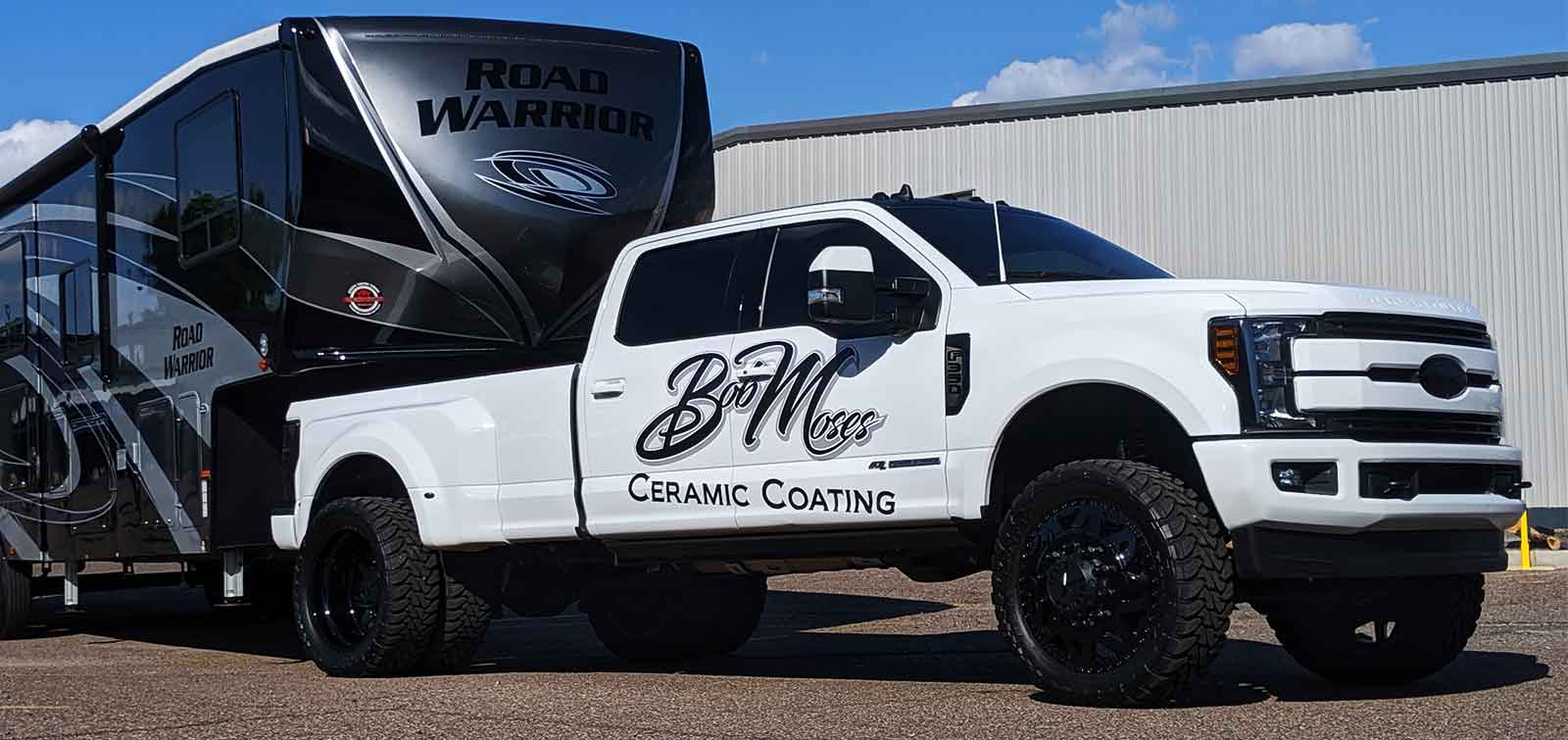
Protecting your car’s paint job is a top priority as it carries heavy weight on the value and look of your car. A ceramic coating removes the consistent hassle associated with protection. So, how long does a good ceramic coating last?
Here at Bob Moses Ceramic Coating, we use Sensha 8-Year Crystal Glow, which when cared for properly should last you the full 8 years on your car paint. How does our product accomplish this task? Let’s dive into the chemistry. Similarly to most professional grade “ceramic coatings”, Sensha Crystal Glow utilizes SiO2 (silicon dioxide) nanoparticles suspended in an epoxy or resin. This resin and silicon dioxide mixture is applied as a liquid and acts as a delivery mechanism to carry the SiO2 nanoparticles into the pores of your car’s clear coat. The mixture then reacts with oxygen in the air and hardens into a crystalline glass structure effectively coating and bonding with the surface of the clear coat. Because the ceramic has effectively penetrated the porous layer of the clear coat and formed a new layer on top of the clear coat, it is very difficult to remove through natural causes. See the data directly from sensha-world.com in Table 1 below. Please note: Bob Moses Ceramic Coating only uses the 8-Year Coating, and so we will focus on these data for this article.
Table 1 – Bond Measurement by Pressure Tape Test
Testing Method: JIS K 5600-5-6
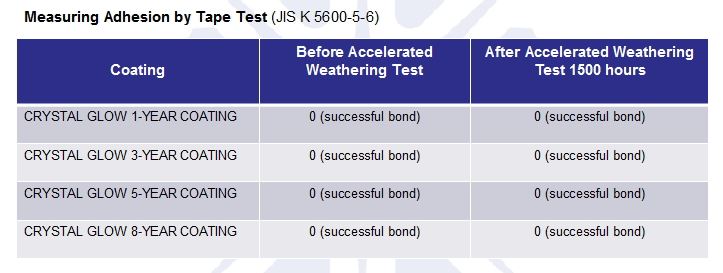
The JIS test utilized measures bond strength between 0 and 5 where 0 is the strongest possible bond and 5 means there is no bond. Table 1 describes that after 1500 hours of Accelerated Weather Testing, Crystal Glow successfully adhered to the tested surface with maximum strength. The accelerated weather test measurement conditions are defined in Figure 1 below. These measurement conditions are designed to create the harshest environments a car would possibly be parked in. The conditions are also consistent over the course of the 1500 hours.
Figure 1 – Contact Angle Measurement Over Time
Testing Method: JIS K 7350-2-1995
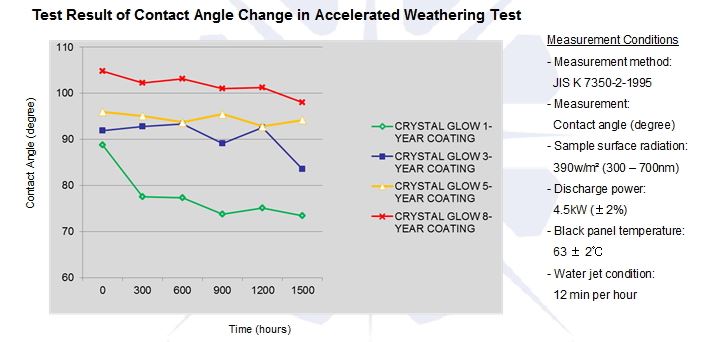
Figure 1 shows the change in the hydrophobic effect on the surface the Crystal Glow ceramic coating is applied to. The most important aspect to make note of through this weather tested sample is that neither of the coatings are maintained properly despite the consistent, intense weathering. Despite this; however, the coatings retain a strong hydrophobic shield on the surfaces. In addition, although the hydrophobic effect remains, there is a clear linear decline in the contact angle (strength of hydrophobicity). Through real customer data gathered by Bob Moses Ceramic Coating, vehicles stored outside in Arizona experience this hydrophobic decline. The decline is heavily quickened if the vehicle is not maintained through washing. There are a multitude of factors that may affect the life of your ceramic coating, but maintenance is the most important.
What Shortens the Life of Your Ceramic Coating?
As a company dedicated to education and honesty, we at Bob Moses Ceramic Coating want you to feel fully knowledgeable about your Sensha Ceramic Coating and all the outside factors that can impact your investment. The following list outlines all the potential causes for failure or a reduction in overall efficacy of your coating such as the loss of hydrophobicity or the decay in gloss.
1. Previous Photooxidation of the Clear Coat
Photooxidation of the clear coat is the process of UV radiation breaking down the chemical bonds of the polymeric compounds in the clear coat mixture. Direct exposure to sunlight is what causes photooxidation. This can cause a few different outcomes in appearance depending on the polymer used in the clear coat. Such examples are: pin-holing, cracking, color change, checking/chicken feet, peeling, dullness, fade, and burn marks. Most clear coats today utilize a very strong polyurethane base, and photooxidation through these examples takes time to really become visible. According to a study conducted by the Ford Motor Group, predicted photooxidation rates of clear coat due to intense sunlight exposure is directly proportional to the length of exposure. They also show that the degree of environmental harshness accelerates the rate of photooxidation. See Figure 2 from their study:
Figure 2 – Change in Photooxidative Exposure in Relation to Environmental Harshness
Figure 3 – Change in Percentage Failure Rates of Clear Coat in Harsh Environments
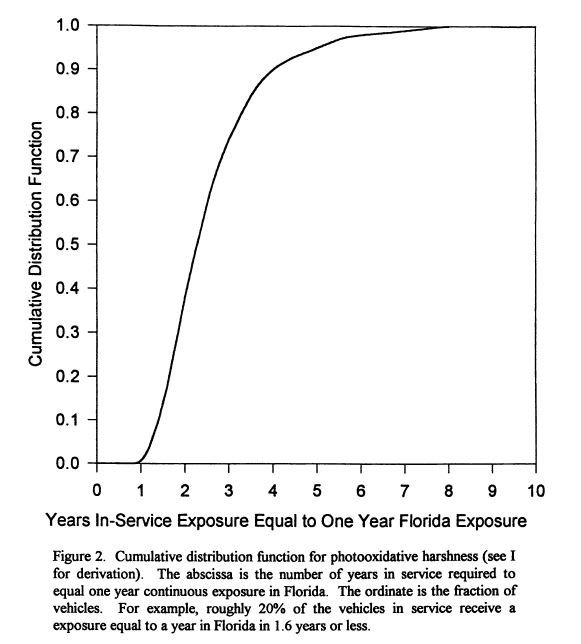
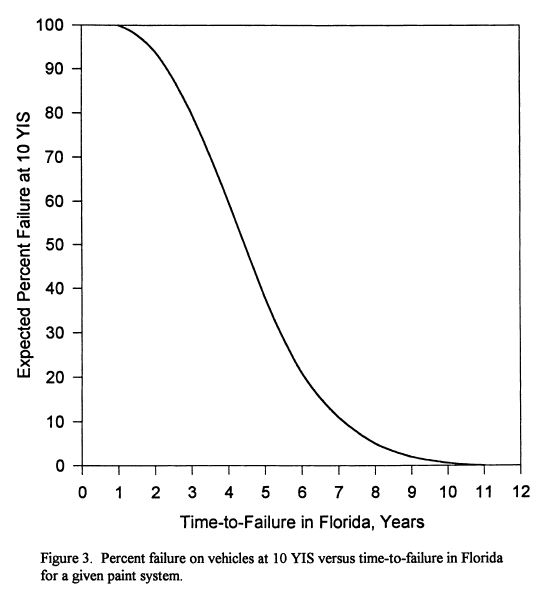
The degree of harshness of the environment to which the car is parked plays the largest role in how long a clear coat is designed to last, or rather as Ford explains it, the time to failure. The group’s study also points out that environments with extreme humidity, extreme dryness, and/or large temperature differentials accelerate the time to failure. This means that if you live in an environment such as Florida or Arizona, your vehicle’s paint is at the highest risk of failing faster than anywhere else in the continental United States. Figure 3 offers the best support to showcase this because as we see the expected failure over the course of 10 years, the percentage of, or likelihood of, clear coat failure is 50% higher after just 5 years of exposure. Ford Motor Group explicitly states that most car manufacturers and manufacturers of clear coat assign an expectation grade for lifespan to be 10 years on any vehicle. (The 10 year lifespan means that failures are supposed to begin at the 10 year mark.) They suggest the average car consumer holds the same expectation as the average car consumer will own their vehicle for approximately 10 years. These data they have collected immediately prove that our expectations of the quality of appearance are entirely subjugated by the physics of nature, and therefore, need to be reduced to account for harsh environmental factors. In short, get your vehicle out of the sun, rain, dust, snow, etc.
The ceramic coating will make it easier to adapt to these environmental factors, but it will not reverse the damage already done to vehicle. The best metaphor is to think of oxidation like burnt skin and a ceramic coating like a sunscreen. Is it best to put on sunscreen before or after the skin is burnt? The answer is obviously before. The sunscreen will not reverse the damage the skin has already sustained. However, more importantly, a car’s clear coat cannot regenerate like skin, so the damage that is present will remain forever. The damage that occurs is a breakdown of the polymers in the clear coat of which the ceramic coating binds to. The less structured the bonding surface, the less strong the bond between the ceramic coating and that surface.
2. Dust, Rain, Acid, Industrial Fallout, and Snow if Left Untreated
There isn’t a place in the world where you can avoid all of these weather conditions except for your garage. But that’s okay, you don’t need to avoid them, and no, you don’t need to have a garage. What shortens the life of your coating is if you let these environmental factors continue to sit and collect on your vehicle. Put simply, you need to wash your car. When you get your car coated with Sensha 8-Year Crystal Glow by Bob Moses Ceramic Coating, we will personally spend time with you educating you on all the proper methods for conducting a wash to help reduce the risk of these factors disrupting your investment.
3. Automated Car Washes
Stop going through the car wash. Period. A hand wash with the proper tools and techniques far exceeds how well a car can be taken care of compared to that of a car wash. Do not take the lazy way out when it comes to your vehicle. The automated car wash with its spinning brushes and rags is literally scratching your car into oblivion, dulling out your paint finish, and cutting away at the already thin layer of clear coat your car has. Because of this, your car will oxidize faster simply because the protective layer, its clear coat, is being tortured and destroyed with each wash. Your ceramic coat is not immune to the car wash either. In fact, it only takes a couple washes through the automated brush wash to completely remove your coating that you invested in.
Now what about touchless car washes? The answer is not necessarily no, but you definitely should not make a habit of it. Car washes tend to use soaps that are basic in pH and are heavy detergents. Both the basicity of the soap and the dose of detergent will eventually wear down your ceramic over time. Not too mention, that most car shampoos and soaps are designed with a filming agent, or top coat. These top coats are similar to waxes and sealants and can give the appearance that your ceramic is no longer functioning as intended. Our suggestion: avoid the car wash altogether unless you are completely stressed for time.
Extend the Life of Your Ceramic Coating
The best and most effective means to prolonging the life of your Sensha 8-Year Crystal Glow ceramic coating on your cars or SUV is to wash your car ideally once every two weeks. You should also wash after a dust storm, heavy rain storm, or a long drive. You will want to use a soap made specifically for a ceramic coated vehicle. This soap should be soft-sudding to help reduce the risk of scratching, be pH neutral, and contain a ceramic base to help add to the current ceramic coat. Bob Moses Ceramic Coating offers two different soaps made by Sensha to assist with washing your ceramic coated vehicle, Body Clean and Power Foam. These two products can be purchased from any Bob Moses Ceramic Coating franchise. Please see the button below to download a PDF that outlines the correct procedures for washing.
Maintenance Products Instructions Sheet
Choose Bob Moses Ceramic Coating for Your Cars
Your car’s paint job is important, so don’t let it fade sooner than it should. Instead, invest in a ceramic coating that will protect your paint for years. To learn more about ceramic coatings and how they protect your paint job, contact Bob Moses Ceramic Coating.
